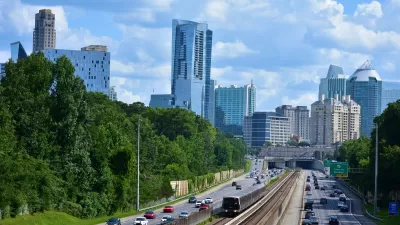It's the best and worst times for public transit. More travelers are turning to transit, but without additional subsidies, public transit across the U.S. is hurting. This editorial look toward the federal government to increase transit funding
"(T)he number of trips taken annually on public transit is now more than 10 billion and rising, compared with 7.8 billion trips in 1995, outstripping population growth and the number of miles traveled on streets and highways."
Yet federal funding has not increased. "Of the 18.4 cents per gallon federal gas tax, only 2.86 cents goes to public transit and almost all of the rest is reserved for highways." The tax has not increased since 1993, unlike transit fares that increase regularly.
"Ridership, which dipped during the recession in 2009, is rising again as more baby boomer retirees take buses and high gas prices push more people to try the thriftier option. Even some cities in areas dominated by cars - like Dallas and Salt Lake City - have expanded their public transit systems."
Consequently, the prediction for America's transit to meet the increased needs is not good.
"We will be back where we were in the 1970s and 1980s, where the older systems across the country are literally falling apart", warned Elliot Sander, chairman of the Regional Plan Association of NY, NJ, and CT.
Thanks to Tony Donovan
FULL STORY: The Recession Squeeze On Buses and Trains

Alabama: Trump Terminates Settlements for Black Communities Harmed By Raw Sewage
Trump deemed the landmark civil rights agreement “illegal DEI and environmental justice policy.”

Planetizen Federal Action Tracker
A weekly monitor of how Trump’s orders and actions are impacting planners and planning in America.

Why Should We Subsidize Public Transportation?
Many public transit agencies face financial stress due to rising costs, declining fare revenue, and declining subsidies. Transit advocates must provide a strong business case for increasing public transit funding.

Understanding Road Diets
An explainer from Momentum highlights the advantages of reducing vehicle lanes in favor of more bike, transit, and pedestrian infrastructure.

New California Law Regulates Warehouse Pollution
A new law tightens building and emissions regulations for large distribution warehouses to mitigate air pollution and traffic in surrounding communities.

Phoenix Announces Opening Date for Light Rail Extension
The South Central extension will connect South Phoenix to downtown and other major hubs starting on June 7.
Urban Design for Planners 1: Software Tools
This six-course series explores essential urban design concepts using open source software and equips planners with the tools they need to participate fully in the urban design process.
Planning for Universal Design
Learn the tools for implementing Universal Design in planning regulations.
Caltrans
Smith Gee Studio
Institute for Housing and Urban Development Studies (IHS)
City of Grandview
Harvard GSD Executive Education
Toledo-Lucas County Plan Commissions
Salt Lake City
NYU Wagner Graduate School of Public Service





























